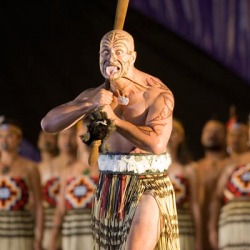Haka
The Haka of the Maori

'Maori Haka dance-photo tour'
I was drawn to the haka due to its intense nature. Nothing about the dance feels held back, everything the performer has is thrown toward the audience in a display of brute force and intimidation. The movements of the arms, legs, and body all give the feeling of great strength, while the facial expressions make one uncomfortable, and reluctant to impose upon the display. This show of force immediately enticed me into looking further into the dances past, and customs.
According to “New Zealand Haka” on squidoo, Haka literally translating to “fiery breath” and is an ancient form of dance originating with the Polynesian people of New Zealand, the Maori. The haka is most familiar to most of the world as a war dance, but as stated in “The Maori” there are actually several different types of haka. There are the well known war haka, such as the “peruperu”, but then there are also haka meant to tell stories, to show joy, or for other ceremonial purposes. Another little known fact revealed in “Haka!” is that it is performed by both sexes. There are specific haka for men, as well as for women, but many haka can be performed by both. The haka which most people are familiar with is the one preformed by the rugby team the All Blacks. This haka resembles the “taparahi”, a haka performed without weapons. The “peruperu” which is a haka performed with weapons was meant to call the Maori god of war “Tumatauenga” and to scare their opponents. Along with invoking the power of gods and intimidating their enemies, the war haka were used as a way of uniting the warriors together, and to warm up their muscles in preparation for the ensuing conflict.
According to “New Zealand Haka” on squidoo, Haka literally translating to “fiery breath” and is an ancient form of dance originating with the Polynesian people of New Zealand, the Maori. The haka is most familiar to most of the world as a war dance, but as stated in “The Maori” there are actually several different types of haka. There are the well known war haka, such as the “peruperu”, but then there are also haka meant to tell stories, to show joy, or for other ceremonial purposes. Another little known fact revealed in “Haka!” is that it is performed by both sexes. There are specific haka for men, as well as for women, but many haka can be performed by both. The haka which most people are familiar with is the one preformed by the rugby team the All Blacks. This haka resembles the “taparahi”, a haka performed without weapons. The “peruperu” which is a haka performed with weapons was meant to call the Maori god of war “Tumatauenga” and to scare their opponents. Along with invoking the power of gods and intimidating their enemies, the war haka were used as a way of uniting the warriors together, and to warm up their muscles in preparation for the ensuing conflict.

'Maori Haka dance-photo tour'
When watching a war haka a person is supposed to feel intimidated. On the opposite end the performer is supposed to be infused with strength and power, possibly due to the adrenalin which the dance seems to be good at drawing out. These were the reactions which I experienced whilst watching, and then subsequently performing the haka. When performing the haka all the movements feel sharp and precise, while at the same time being heavy. When the movements are added with the chant and sound from the body movements the feeling is invigorating and stimulating. During and after performing the haka it is as if you could jump over a mountain, or in the case of the Maori or the All Blacks enter into combat.
The Maori created a very distinctive form of dancing which has managed to persist even though European colonials tried to eliminate it. After hundreds of years the dance has changed little from when it was performed in preparation for a coming battle. This persistence of the dance gives credit to the creators. The Maori are clearly a resilient and proud group of people, who even after the European colonists changed much of their way of life managed to hold onto their ancient customs. The haka was created to show off the strength and ferocity of those who performed it, thus it is an easy assumption that the Maori who created it were a strong and fearless group.
The Maori created a very distinctive form of dancing which has managed to persist even though European colonials tried to eliminate it. After hundreds of years the dance has changed little from when it was performed in preparation for a coming battle. This persistence of the dance gives credit to the creators. The Maori are clearly a resilient and proud group of people, who even after the European colonists changed much of their way of life managed to hold onto their ancient customs. The haka was created to show off the strength and ferocity of those who performed it, thus it is an easy assumption that the Maori who created it were a strong and fearless group.

